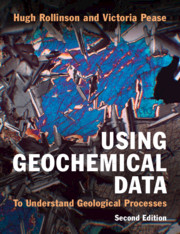Book contents
- Using Geochemical Data
- Reviews
- Using Geochemical Data
- Copyright page
- Contents
- Preface to the Second Edition
- Preface to the First Edition
- Abbreviations
- 1 Geochemical Data
- 2 Analysing Geochemical Data
- 3 Using Major Element Data
- 4 Using Trace Element Data
- 5 Using Geochemical Data to Identify Tectonic Environments
- 6 Using Radiogenic Isotope Data
- 7 Using Stable Isotope Data
- Appendices
- References
- Index
6 - Using Radiogenic Isotope Data
Published online by Cambridge University Press: 15 April 2021
- Using Geochemical Data
- Reviews
- Using Geochemical Data
- Copyright page
- Contents
- Preface to the Second Edition
- Preface to the First Edition
- Abbreviations
- 1 Geochemical Data
- 2 Analysing Geochemical Data
- 3 Using Major Element Data
- 4 Using Trace Element Data
- 5 Using Geochemical Data to Identify Tectonic Environments
- 6 Using Radiogenic Isotope Data
- 7 Using Stable Isotope Data
- Appendices
- References
- Index
Summary
Geochemists use radiogenic isotopes in geochronology and in petrogenetic studies. In geochronology isotopes from the K–Ar, Rb–Sr, Sm–Nd, Lu–Hf, U–Th–Pb, and Re–Os systems are used in isochron calculations and in the calculation of model ages. The concepts of closure temperature and the meaning of a geological ‘age’ are discussed. In petrogenesis radiogenic isotopes are used to identify different crust and mantle reservoirs as sources of magmatic rocks and to chart the isotopic evolution of the crust and mantle over time. The epsilon and gamma notations for normalising isotopic compositions relative to that of the chondritic uniform reservoir (CHUR) are described. The recognition of different mantle reservoirs and their evolution over time provides the basis for understanding large-scale processes in the mantle which feed into geodynamic models for the crust and mantle.
Keywords
Information
- Type
- Chapter
- Information
- Using Geochemical DataTo Understand Geological Processes, pp. 178 - 218Publisher: Cambridge University PressPrint publication year: 2021
